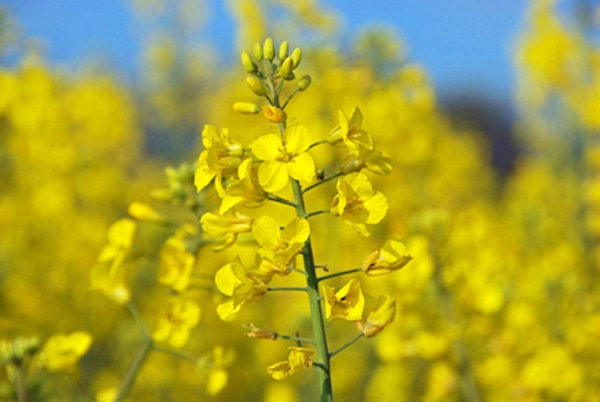December 20, 2010

Favorable weather has been good news for farmers growing winter canola in the Southern Plains this year.
Approximately 110,000 acres of the oilseed crop, the most in its short production history in the region, is growing in North Texas, Oklahoma and Kansas, says Gene Neuens, Producers Cooperative Oil Mill (PCOM) field representative at Oklahoma City.
"We have looked at the crop from the Texas and Oklahoma Panhandle areas and everywhere else," Neuens said. "With recent winter freezes, the crop is going into its dormant stage.”
Earlier stages of the 2010 crop also fared well. “We had good moisture for planting last September and a warm fall that permitted the crop to grow well until cold weather set in."
PCOM and Oklahoma State University Extension specialists are keeping an eye on some minor problems, Neuens said. Some fields have canola plants too small and other fields have plants that are too big.
"A lot of cold, dry weather could be harmful to those smaller plants," he said, "and the larger plants will need extra nitrogen to keep them growing well when spring temperatures start the crop growing again."
But overall, the 2010 canola crop is on track for its winter growth hiatus.
Insect problems
Some insect depredation occurred in the fall in a few areas, according to Josh Bushong, OSU Extension Service specialist for canola production.
Bushong, Enid, Okla., began working with farmers in northwest Oklahoma earlier this year.
He has observed limited insect problems in canola fields from diamondback moth larvae and armyworms, he said.
"There was a need to use insecticides on a few fields to control the pests," Bushong said. "But in most cases, the crop was growing well enough to avoid applying insecticides. We have not seen aphids in the canola crop this year."
Bushong is pleased with the condition of the crop so far. While the crop started out with adequate soil moisture earlier in the fall, he has seen some areas where more moisture will be needed when the crop starts growing in the spring.
There has been much interest in winter canola production this year for several reasons, but two stand out in particular, Neuens said.
"Winter canola was specifically chosen less than a decade ago as a crop to reduce the huge weed problem winter wheat producers were fighting in the Southern Plains. Originating from spring canola varieties typically grown in northern states and Canada, crop breeders developed new varieties of the crop that would grow in winter months, similar to hard red winter wheat, which is grown on millions of acres across the U. S."
Monoculture
Decades of continuous wheat production helped create infestations of perennial weeds like cheatgrass, winter rye and other plants whose population grew each year in wheat fields.
As the weeds spread throughout the Plains states, farmers found that herbicide application was often too expensive to control the weeds.
OSU weed scientist, Dr. Tom Peeper, along with other agronomists at OSU and Kansas State University and seed production companies, began a cooperative effort six years ago to develop winter canola as a viable solution to the winter wheat weed problem.
Scientists found winter canola, an oilseed crop, featured good growing characteristics for the same areas where wheat had been grown for decades. Canola has a large taproot able to seek deep soil moisture in dryland farming conditions, and when planted after wheat it breaks up the growth cycle of the weeds competing with wheat.
Growers are losing less to dockage when they follow canola with wheat. Weed seeds found in wheat seed taken to market when the wheat is harvested each spring will sharply reduce prices paid for wheat.
Canola also has proven a marketing success.
When winter canola was first planted in enough acres to help control weeds in winter wheat, finding a reliable market for the crop was difficult; some of the larger canola producers sent seed as far as Mexico to be processed.
Marketing problems were solved when the Producers Cooperative Oil Mill, which has been processing cottonseed for varied markets for more than 64 years, entered the canola marketing arena.
Now, farmers have local grain terminals where they can deliver canola seed, bought by PCOM. Prices paid for canola usually run $2 to $3 per bushel more than winter wheat. Currently, cash price for winter canola is $9.45 per bushel compared to $6.92 per bushel for winter wheat.
Winter canola production in the Southern Plains is expected to increase as more farmers place it in their diversified crop program, Neuens said.
You May Also Like




